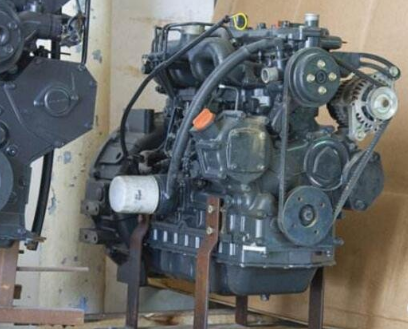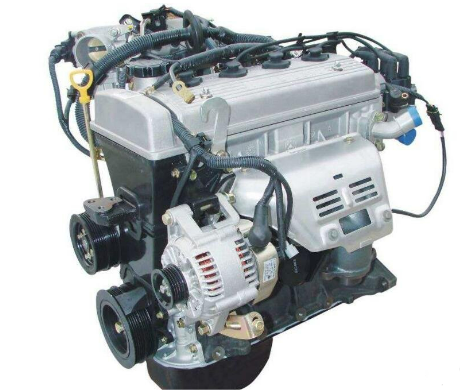
Privacy statement: Your privacy is very important to Us. Our company promises not to disclose your personal information to any external company with out your explicit permission.
![]() June 21, 2022
June 21, 2022
An engine assembly, also known as an engine, is a machine that converts one form of energy into another, more often, converting chemical energy into mechanical energy (a motor that converts electrical energy into machine energy). Sometimes it applies to both the power generating device and the entire machine including the power unit. Such as gasoline engines, aero engines.

Automobile engines generally obtain kinetic energy by internally burning gasoline (diesel), so the automobile engine is an internal combustion engine.
1. According to the fuel used: it can be divided into gasoline engine and diesel engine. Gasoline engine and diesel engine have their own characteristics; gasoline engine has high speed, low quality, low noise, easy starting and low manufacturing cost; diesel engine has large compression ratio, high thermal efficiency, and emission performance and economic performance are much better than gasoline engine.
2. According to the piston movement mode: the piston type internal combustion engine can be divided into two types: reciprocating piston type and rotary piston type. The former piston reciprocates linearly in the cylinder, and the latter piston rotates in the cylinder.
3, according to the number of cylinders: can be divided into single-cylinder engines and multi-cylinder engines. An engine with only one cylinder is called a single cylinder engine; an engine with more than two cylinders is called a multi-cylinder engine. Modern car engines use three-cylinder, four-cylinder, six-cylinder and eight-cylinder engines.
4, according to the arrangement of the cylinder is different: can be divided into single-row, double-row and three-column. The individual cylinders of the single row engine are arranged in a row, generally vertically, but in order to reduce the height, the cylinders are sometimes arranged to be inclined or even horizontal. The double-row engine arranges the cylinders in two rows. The angle between the two columns is 180° (generally 90°), which is called a V-type engine. If the angle between the two columns is 180°, it is called an opposed engine. The three-row type arranges the cylinders into three rows to become a W-type engine.
5. Classification by stroke: The internal combustion engine can be divided into a four-stroke internal combustion engine and a two-stroke internal combustion engine according to the number of strokes required to complete a working cycle. Automobile engines generally use a four-stroke internal combustion engine. A four-stroke internal combustion engine means that one working cycle is completed, the piston reciprocates four strokes up and down in the cylinder, the crankshaft is rotated two times (720°), and the two-stroke internal combustion engine is one-half of the working process.
6. According to the intake system, the boost mode is adopted: it can be divided into supercharged (forced intake) and non-supercharged (naturally aspirated). The use of a supercharger to increase the intake pressure and increase the intake density is a supercharged internal combustion engine, which is advantageous for increasing the power of the internal combustion engine. The intake air that is carried out in an near-atmospheric state is a non-supercharged internal combustion engine or a naturally aspirated internal combustion engine;
7. Classification according to cooling method: The internal combustion engine can be divided into water-cooled engine and air-cooled engine according to different cooling methods. The water-cooled engine is cooled by using a coolant circulating in the cylinder block and the cylinder head cooling jacket as a cooling medium; and the air-cooled engine uses air flowing between the cylinder block and the fin on the outer surface of the cylinder head as a cooling medium. Cooling. The water-cooled engine is evenly cooled, reliable in operation and good in cooling effect, and is widely used in modern vehicle engines.

Looking back at the history of engine generation and development, it has experienced two stages of development of external combustion engines and internal combustion engines.
The so-called external combustion engine, that is, its fuel is burned outside the engine, the engine converts the heat energy generated by this combustion into kinetic energy. The steam engine invented by Watt is a typical external combustion engine. When a large amount of coal is burned, heat is generated. When heated into a large amount of water vapor, high pressure is generated, and then this high pressure pushes the mechanical work, thereby completing the transition of thermal energy to kinetic energy.
Understand what is an external combustion engine, and know what an internal combustion engine is. The biggest difference between this type of engine and the external combustion engine is that its fuel burns inside. There are many types of internal combustion engines. Our common gasoline and diesel engines are typical internal combustion engines. Our less common rocket engines and jet engines assembled on aircraft are also internal combustion engines. However, due to the different power output methods, there are huge differences between the first two and the latter two. In general, most of the use on the ground is the former, and the latter is mostly used in the air. Of course, some automakers have used jet engines for the purpose of creating a new record for the world's car speeds, but this is always a very special case and there is no applicability for mass production.
In addition, there is a gas turbine, which is characterized in that combustion combustion produces high-pressure gas, and the high pressure of the gas drives the blades of the gas turbine to rotate, thereby outputting power. Gas turbines are used in a wide range of applications, but because it is difficult to fine-tune the output power, gas turbines are rarely used in cars and motorcycles, and only some cars are equipped with gas turbines.
Human wisdom is endless, and various new types of engines are constantly being developed. However, for the sake of safe handling, so far, our lovely motorcycle has only one choice - reciprocating engine.

The above is the What components are included in the engine assembly we have listed for you. You can submit the following form to obtain more industry information we provide for you.
You can visit our website or contact us, and we will provide the latest consultation and solutions
Send Inquiry
Most Popular
lastest New
Send Inquiry

Privacy statement: Your privacy is very important to Us. Our company promises not to disclose your personal information to any external company with out your explicit permission.

Fill in more information so that we can get in touch with you faster
Privacy statement: Your privacy is very important to Us. Our company promises not to disclose your personal information to any external company with out your explicit permission.